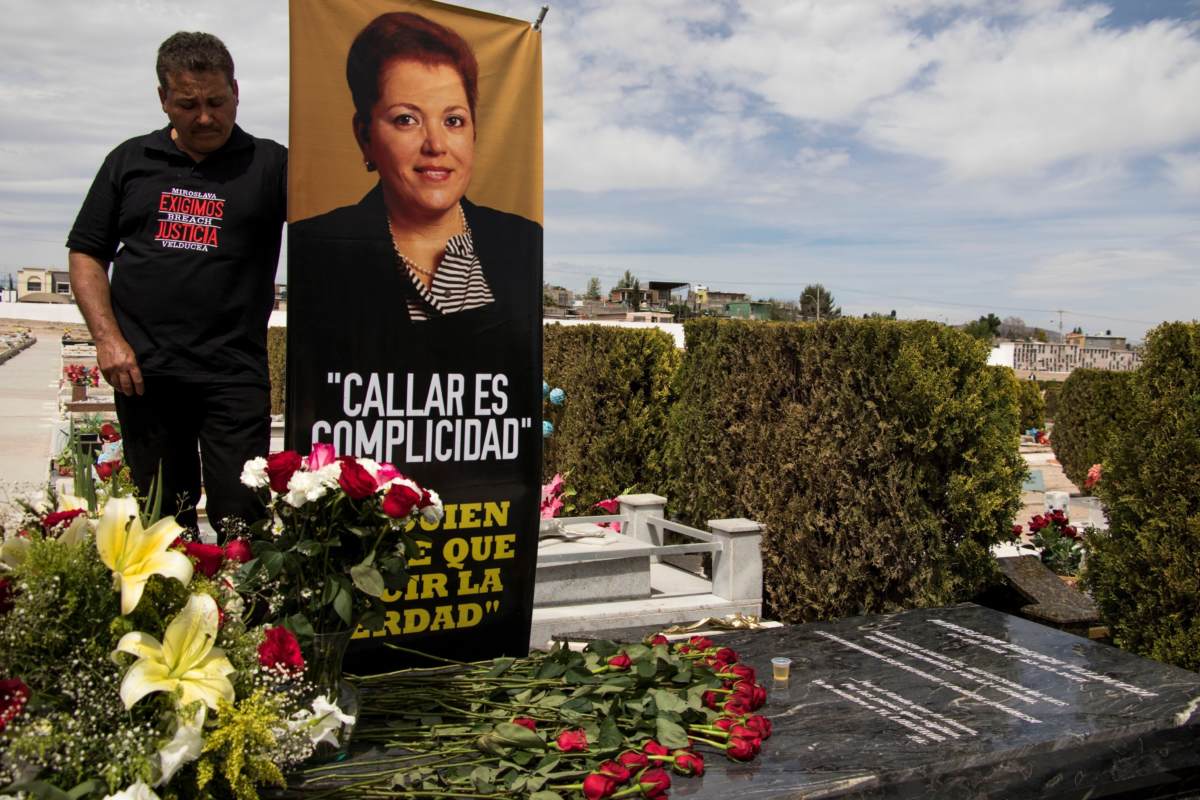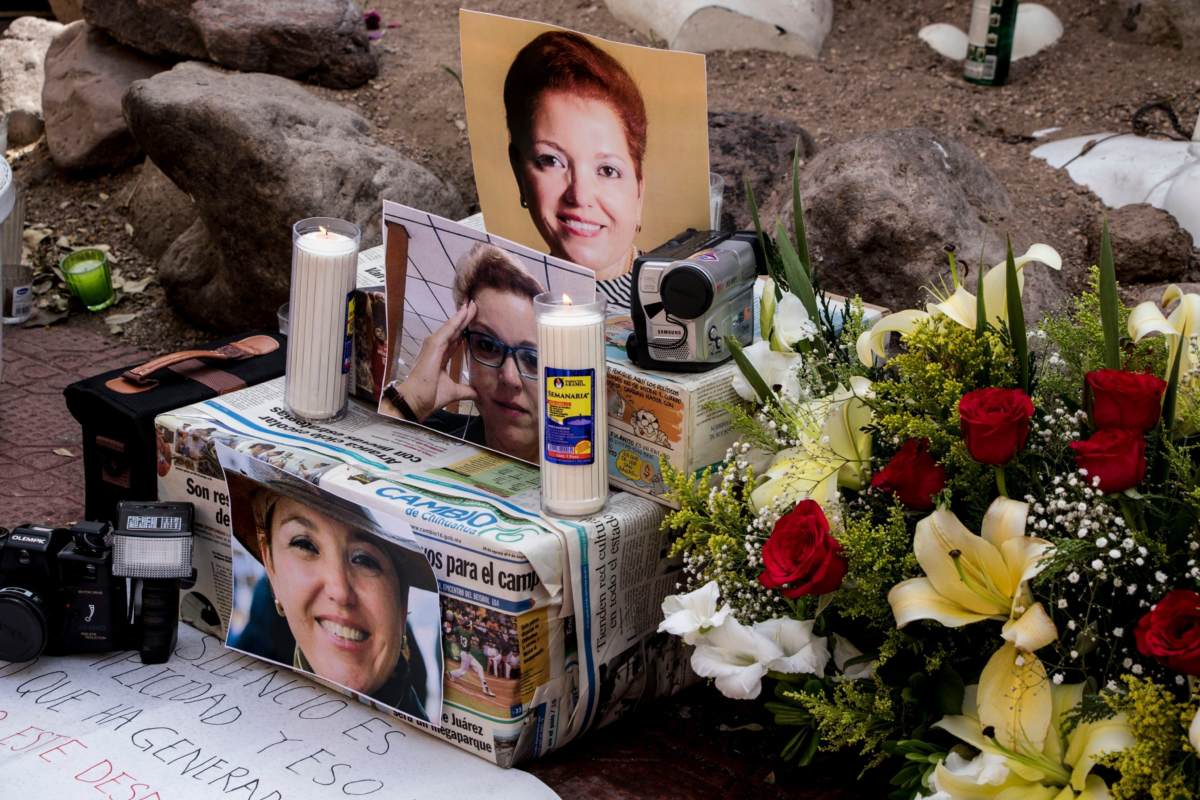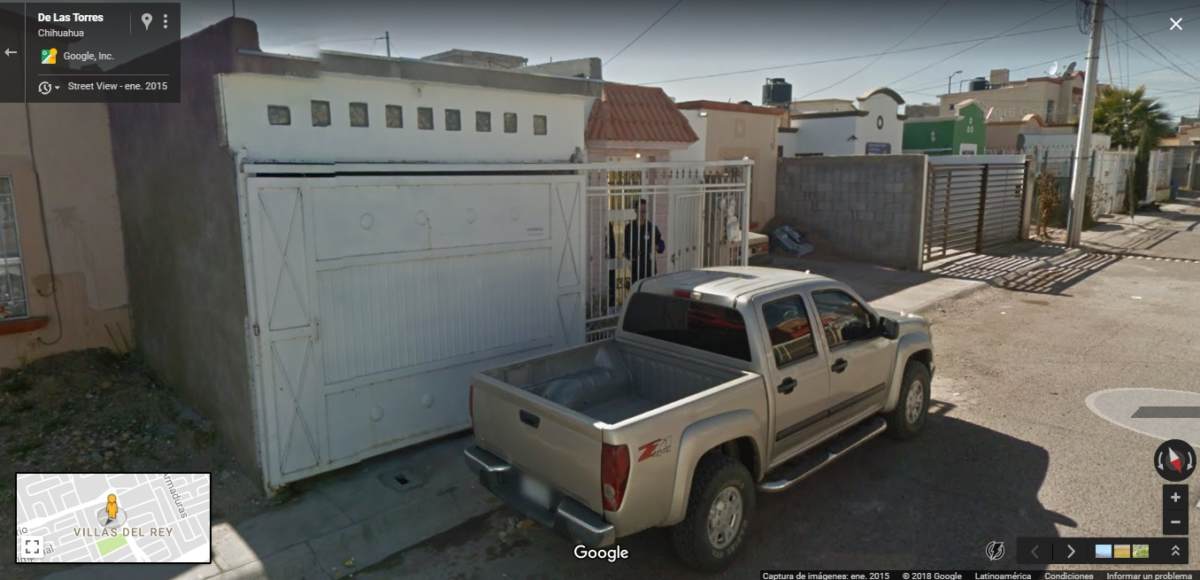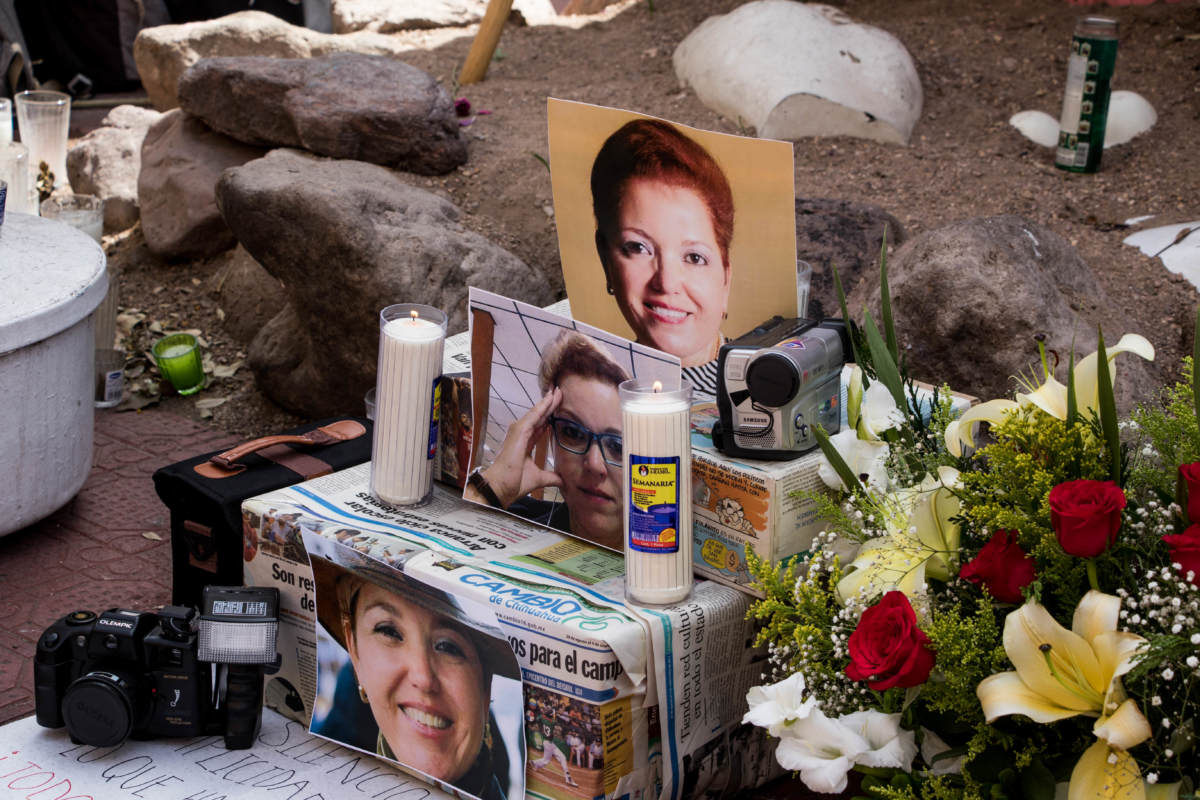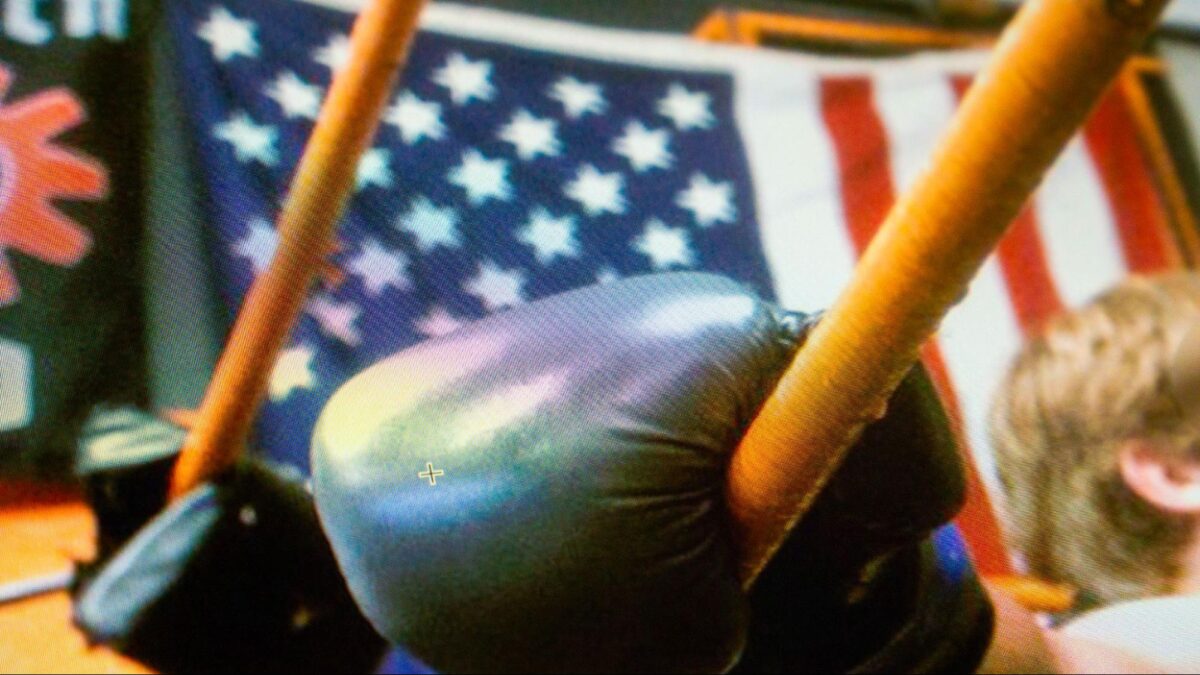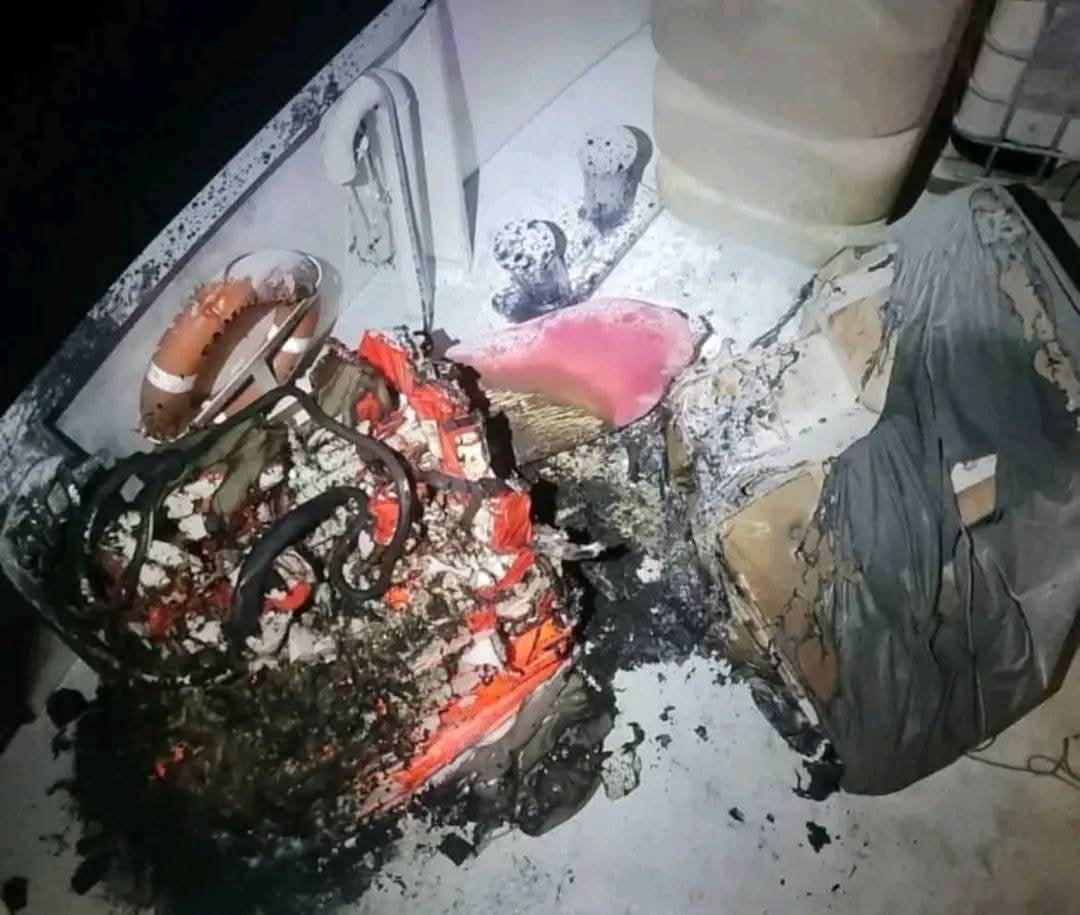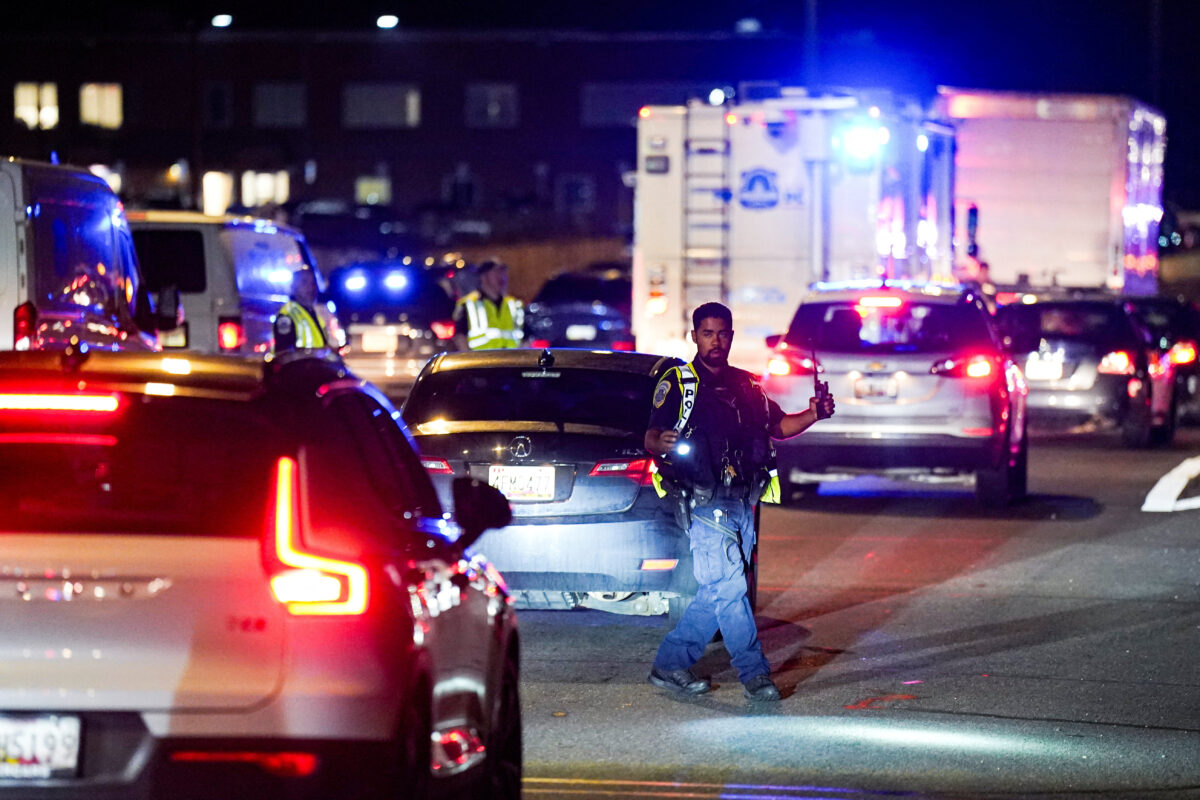The Leads Not Investigated In The Miroslava Breach Murder
Over the past 10 years, at least 82 journalists have been killed in Mexico for exercising their profession. This gruesome death toll makes Mexico one of the most dangerous countries for journalists in the world. One victim of this violence was Miroslava Breach, an investigative journalist who had been reporting on “narco-politicians”, members of drug cartels who infiltrate the country’s political life to consolidate their control. On the 23rd of March 2017, Breach was shot dead in cold-blood outside her home. Since then, the investigation into her death has left loose ends. El Colectivo 23 de marzo, a group of journalists working in Mexico, in collaboration with international journalism organizations Forbidden Stories, Bellingcat, and the Latin American Center for Investigative Journalism (CLIP), joined forces to reveal what authorities have investigated and what not regarding this crime that must not be left unpunished.
By Colectivo 23 de Marzo and international allies
On March 23, 2017, at 6:49 in the morning in the city of Chihuahua, a journalist named Miroslava Breach Velducea was waiting inside her vehicle for her son, whom she was going to take to school. A man walked up to the car and shot her through the windshield and the window on the driver’s side. He fired eight shots, which hit her arms, face and neck. Then, the killer left down the same sidewalk on which he had arrived and escaped in a vehicle that was waiting for him a few blocks away.
Breach’s eldest daughter ran out of the house when she heard the shots and her brother’s screams. She found her mother leaning towards the passenger’s seat, motionless. She called an ambulance, but the police arrived first. Her mother was dead.
It quickly became clear that the murder victim was a veteran correspondent with national newspaper La Jornada, a respected columnist and former editor-in-chief of the El Norte de Ciudad Juarez newspaper. She was a courageous and wise 54-year-old who, despite having received threats, continued her work of documenting the narcopolitics in that state, which was convulsing with confrontations between the armed groups that had grown under the protection of political powers. Without a doubt, the killing was targeted, planned, and professional.
Javier Corral, the newly elected governor of Chihuahua state and an old friend of Miroslava, promised that the investigation would become a “national model” for solving crimes against journalists, an ambitious promise in a country where 99% of such cases remain unsolved. The line of inquiry, he said two days later, would be narcopolitics.
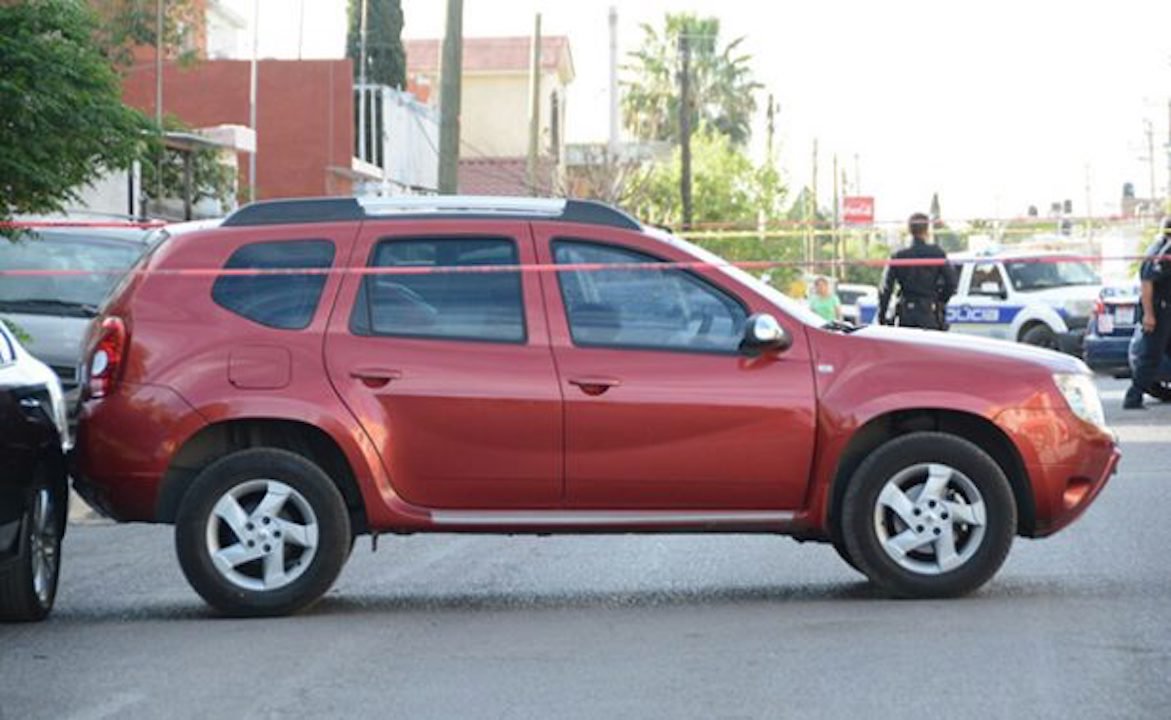
Miroslava Breach was shot eight times outside her home while waiting to take her son to school. Source: El Heraldo de Chihuahua
“The crime was meticulously planned. It was meant to silence her journalistic work, and I say this because [her work] was focused directly on these links to narcopolitics”, said Corral in an interview with Proceso magazine.
This version of the murder was credible. Miroslava had written about the collusion between governments and organized crime groups—the so-called “narcopolitics”—and the impunity with which these operated in the Chihuahua highlands. Between 2015 and 2017, she published seven stories (a mix between op-eds and investigations) focusing on an illegal group that operates in the Chínipas municipality, controlling both the south of Chihuahua and the mountainous borderland with the state of Sonora. This family clan, dubbed Los Salazar, Los Salazares or New People Salazar, works for the so-called Sinaloa Cartel, the criminal structure led by Joaquín “El Chapo” Guzmán, recently convicted to life sentence in the US. The clan’s founder, Adan Salazar Zamorano, formerly included in the most wanted list of the United States Drug Enforcement Administration (DEA) and his son Alfredo Salazar Ramirez are both currently in high-security prisons.
Since the year 1999, Miroslava had sporadically published pieces on the group’s incursion in Chihuahua, the curfews that it imposed in the highlands, the routes that it was opening for marijuana and cocaine traffic, and the protection that it received from different authorities. In 2015, she wrote about the forced displacement of communities as a result of the violence generated by these criminals. Miroslava knew the group and its leaders well. She was a native of the town of Chínipas and grew up in southern Sonora.
In the elections that Corral won, she—alongside a correspondent from Proceso magazine—had managed to unmask two local candidates for municipal president from the Partido Revolucionario Institutional (PRI, the party governing the country at the time), revealing in March 2016 that they were related to drug traffickers. Arturo Quintana, nicknamed El 80 a regional leader of the Juarez Cartel, had chosen his mother-in-law as candidate for mayor in Bachíniva; and in Chínipas, a town in Chihuahua state, Juan Salazar Ochoa, a.k.a. Juanito, and nephew of Adán Salazar, was also running for mayor in Chínipas.
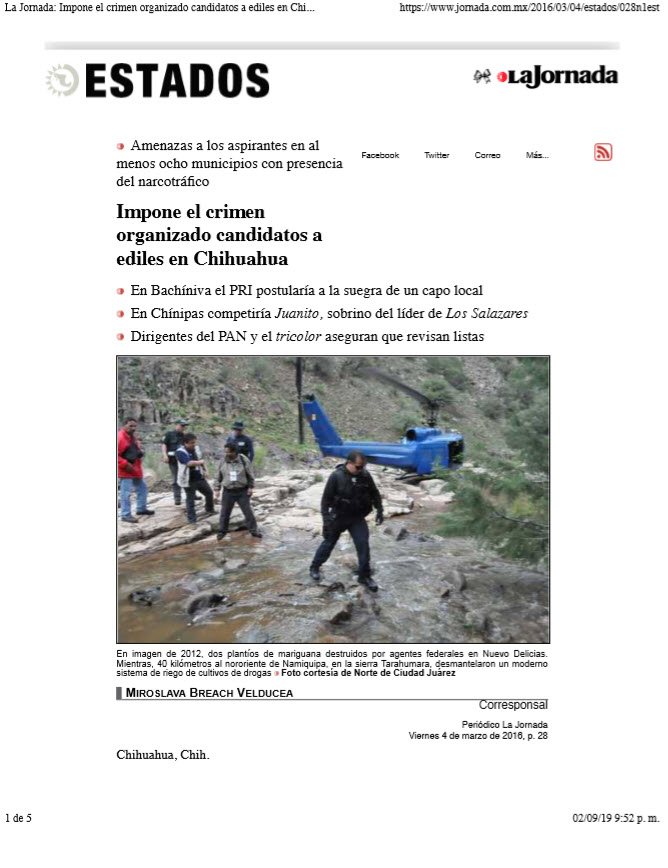
An article by Breach that resulted in an increase in threats made against her. The article is titled “Organized Crime Runs Candidates for Chihuahua Elections”. La Jornada, 04/03/2016: https://www.jornada.com.mx/2016/03/04/estados/028n1est
The threats began after the journalists published this information. Miroslava first received an intimidating warning via telephone from someone she knew about the danger in which she and her colleague from Proceso were in. Later, she was called by a public official who insisted that they should reveal how they had gotten their information. Then, the same message came from a politician. All the threats originated from Chínipas. Colleagues and friends coincide in that Miroslava had alerted Corral about her situation weeks before he became governor. During that time, she published seven stories on the topic: the last came one month before her murder and outlined how drug traffickers had infiltrated governments and police in ten municipalities, Chínipas, among them.
In the two years and five months after the murder of Miroslava Breach Velducea, her crime is still unpunished, and 28 other Mexican journalists have been murdered. As a result of official investigations, Juan Carlos Moreno Ochoa (a.k.a. El Larry) is currently in jail awaiting sentencing, having been presented as authorities as lieutenant of Los Salazar in Chínipas and mastermind and orchestrator of the murder. His alleged accomplice Wilberth Jaciel Vega Villa, who is godson of imprisoned Jesus Alfredo Salazar (who has been requested in extradition by the US), is a fugitive. The person accused by the office of the Prosecutor of the State of Chihuahua as the triggerman who shot the journalist eight times, Ramon Andres Zabala Corral, from Sonora, was murdered five days before El Larry was arrested.
Even though the alleged mastermind of the killing is in prison, the triggerman is dead and the third accomplice is a fugitive, the most important element of the investigation has yet to be made clear: If “narcopolitics” are at the root of the case, what is the relationship between the criminals who murdered Miroslava and political groups and figures? What was the role that these political groups played in the planning and executing of the murder against the journalist? And, above all, why did they kill her?
While at first sight the official investigation seemed exemplary and the evidence presented at the start of the trial against El Larry appeared based on scientific evidence, the case file numbered 19/2017-8019 at the Prosecutor’s Office of the State of Chihuahua, taken over in April 2018 by the Specialized Division on Crimes Against the Freedom of Expression (FEADLE) at the Federal General Prosecutor’s Office, cannot hide its shortcomings. There are leads that were never followed; politicians who were never duly interrogated; persons who might have had some level of participation in the murder and were nonetheless granted protected witness status; irregularities at the scene of the crime; inconsistencies within the evidence and information leaks to the press that served to distract public opinion on the case.
The case files also reveal that the relationship between Miroslava’s work and the threats that she received did not open new avenues for investigation. Her allegations have not resulted in questions asked to the individuals whom Miroslava mentioned in her work.
It is not known what information was gleaned from Miroslava’s work laptop, as well as from her three cellphones, three USB drives and a hard drive that her family gave to the legal authorities, which would reveal what topics she was investigating. Her case file only contains a superficial analysis that relies on numerical data (for example, 81 files contained the word “Chínipas”).
The Colectivo 23 de Marzo, comprising journalists working in Mexico, in collaboration with the international organizations Forbidden Stories, Bellingcat, and the Latin American Centre for Investigative Journalism (CLIP), was created to investigate a crime that must not remain unpunished. Truth cannot be eliminated by killing journalists. This story is based on open source information, interviews with involved parties, following up on press reports, processing testimonies from trials and by accessing official information and witness statements. We have been careful not to put witnesses at risk and hope this contributes to due process of justice.
“Silence is collusion”, said Miroslava when she was threatened, and she repeated this when she was asked to stop doing her investigations. As journalists of the Colectivo 23 de Marzo, we chose not to accept the silence of the official version. In this investigation we ask some of the questions that those tasked with administering justice have not answered so far.
The “Exemplary Investigation”
(Miroslava’s case will help solve other crimes: Javier Corral. https://www.youtube.com/watch?v=0AWIjXpr0Mg. Source: Mujeres es más)
The Office of the Chihuahua State Prosecutor published the results of its “exemplary investigation” to combat impunity against journalists that had been promised by governor Javier Corral on December 27 2017, nine months after Miroslava’s murder, during a hearing that, until today, has only resulted in one arrest: that of Juan Carlos Moreno Ochoa.
This previously unknown 44-year old man from la Sierra was accused throughout the trial by at least four witnesses of being a drug trafficker and of being armed, of travelling by private airplane, of having people at his command, of using and selling cocaine, and of having under his control the municipality of Chínipas. His lawyer insisted that he is a cattle rancher.
On the week of his arrest, a narcocorrido in his honour was released. Its lyrics describe him as a man “with the Salazar tag” with “a [pistol] at his waist and a sophisticated radio”, who despite living in Chínipas, travels throughout the highlands and even to the beach.
(The El Larry narcocorrido. https://www.youtube.com/watch?v=siRG2uDSTbM. Source: Lupe Borbon y Su Blindaje 7)
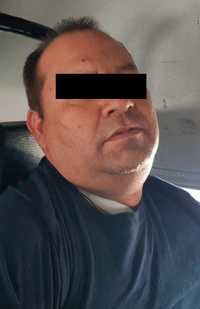
El Larry was arrested on December 25, 2017. He is the alleged Los Salazar lieutenant in the Chihuahua highlands, in northern Mexico, and the inspiration for a narcocorrido. Source: Chihuahua State Prosecutor General of Justice
According to the official version of events, at 6:00 AM on the day of the murder, El Larry got into a white Malibu in the Villas del Rey neighbourhood of Chihuahua. The vehicle was being driven by a man whose boss had asked him to drive El Larry around whenever he was in the city. The driver would later become a witness with protected identity by the nickname Cholugo. That morning, they left for the Granjas neighbourhood trailing a grey Malibu, carrying a university student named Wilberth Jaciel Vega Villa and Andrés Zabala Corral, the man identified as the triggerman.
The vehicle in which Larry and Cholugo were travelling stopped a few blocks away from Miroslava’s home, while the grey Malibu continued towards José María Mata street. Zabala Corral exited the vehicle with a white object beneath his arm and walked towards Miroslava’s car, where she was waiting for her son to come out. He shot her in cold blood in two bursts: first through the windshield, then through the window on the driver’s side. The event was recorded by five private security cameras, which registered that the event took place before 6:50 AM.
There were eight bullet casings with the inscription “.38 super” left at the scene of the crime. On the pavement a few meters from Miroslava’s vehicle—which had gone into reverse and hit a car parked on the opposite sidewalk—was a cardboard sign that, according to the authorities, was the white object that the triggerman carried underneath his arm.
(The triggerman was captured on security camera footage. He carried beneath his arm a white object that the Chihuahua authorities identified as a cardboard sign that was found at the crime scene. https://www.youtube.com/watch?v=zIVomPWrw7w. Source: Fiscalía General de Justicia del estado de Chihuahua.)
Five minutes after the murder, the municipal police arrived followed by the Red Cross, which confirmed that Miroslava was dead. Thirty-five minutes after the event, state police officers arrived to process the crime scene and collect evidence.
However, in this apparently impeccable reconstruction of events, there are many inconsistencies.
The Cardboard Sign
(Miroslava Breach murdered in Chihuahua. https://www.youtube.com/watch?v=iTkg8PWC788. Source: El Tiempo TV)
Just after photographers arrived on the crime scene to take pictures, the first images of a cardboard sign on the street began circulating. Later, a drone sent by the newspaper El Tiempo captured images of the scene, where the cardboard sign is no longer seen on the pavement.
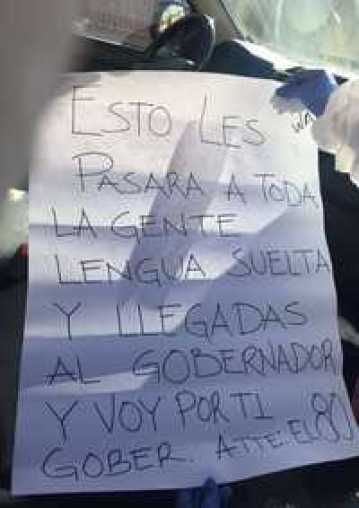
Image leaked to media showing the cardboard sign that the authorities claim to have found at the crime scene. Source: Chihuahua State Prosecutor General of Justice
“This is what will happen to anyone with a loose tongue and who is close with the governor and I’m coming for you Gov. From: El 80”. According to the case file, this was the message written on the sign.
It is noteworthy that during the first hours of the investigation, there were different versions of the cardboard sign’s content. This fact was established by 73 journalists, the majority of which hailed from Chihuahua, who penned an open letter to the governor questioning information leaks from his office. Part of that letter reads:
Why are there three different versions of the alleged sign which attributes the crime to Carlos Arturo Quintana, El 80 and leader of the Juarez Cartel?
The first version, from Thursday March 23, at 12:39 PM: “For having a loose tongue.”
The second version, from Thursday March 23 at 4:00 PM: “For having a loose tongue. Continue on governor. El 80”.
The third version, from Saturday March 25 at 6:43 AM: “This is what will happen to anyone whose tongues are loose and who is close with the governor and I’m coming for you Gov. From: El 80”
The finding of this supposed narco-message, its location and its content targeting the governor was called into question from the very day of the murder in an op-ed published in La Opinion which reads:
In the first reports, there was only reference to a rolled up, crumpled cardboard, that had been thrown on the pavement. Later, from governor’s office its supposed text was leaked: that [Miroslava] had been killed for talking too much and being a follower of the governor, as signed by El 80. On the other hand, it was said that the sign had appeared mysteriously, almost eagerly in order to give wind to the officials’ sails (…) How strange that after the murder of Miroslava Breach, her killer left a message—not folded, but rolled up—which is different from how other hitmen operate. It is even stranger that they left this sign on the floor, some five or six meters from [Miroslava’s] vehicle and on the opposite side of the street from which the killer fired his weapon, and also on the opposite side of what would have been his fastest, most immediate escape route.
At the same time, a close relative of Miroslava said that after governor Corral came to give his condolences to her family that morning (they were old friends, after all), a state official came and showed them a picture of the sign on his cellphone. This relative remembers that the sign contained the word “lenguona” (roughly, “someone who talks too much”) and not the phrase “loose tongue”, which is what the image later leaked to the media said.
When the national-level Attorney General’s Office analyzed Miroslava’s computer, investigators searched keywords such as “El 80”, “Chínipas”, “narco” and “lenguona”, but did not search “lengua larga” [literally, “long-tongue”].
These differences might seem unimportant were it not for the fact that the official investigation of the homicide considered the cardboard sign and its message as key evidence to identify the perpetrators of the crime: Jaciel Vega Villa, whom the district attorney accused of writing the message as a result of handwriting analysis which compared the sign’s text with some of his writings, and El Larry, identified as the person who signed it.
El Wawa
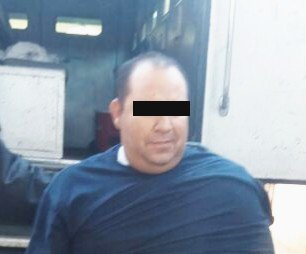
According to the Chihuahua state prosecutor’s office, El Larry was arrested in the Etchojoa municipality of Sonora state. Source: Chihuahua State Prosecutor General of Justice
The case file includes an image of the cardboard sign found several meters away from the spot where Miroslava was murdered. The message, unfolded and held up by a pair of gloved hands inside a vehicle, is written in a neat, clear and straight handwriting. However, the case file does not indicate who unrolled the sign or why the image was taken inside a vehicle, information which is important to establish a chain of custody for the piece of evidence.
The sign contains the inscription “Wa” on each top corner, which according to the Chihuahua Prosecutor’s office is the signature of Juan Carlos Moreno Ochoa, who is supposedly known as Wawa. However, most witnesses who spoke to the Public Ministry identified Moreno Ochoa with another moniker: El Larry. The only person who mentioned someone identified by the nickname Wawa is protected witness Cholugo, who testified that several months before the murder he heard his boss, known as witness 1981, speaking on the telephone to someone who he asked to say hello to Wawa. However, Cholugo admitted that he did not know who his boss was speaking to, nor to whom the greeting was intended.
The inscriptions reading ‘Wa’ were absent from the first media reports.
A report compiled by FEADLE two days after the murder that included a description of the sign does not mention the “Wa” inscriptions either. In fact, the sign that FEADLE had access to had damaged corners, according to the file. Another detail: the report states that the sign was grey, rather than white.
Moreover, one obvious fact remains unexplained: if the warning was already signed by El 80, why would someone who wanted to accuse another person of committing the crime would then add his own signature to the sign?
The Slit Window
After locating and examining hours of security camera footage from nearby homes and streets, the state authorities soon found images of the grey Malibu “with a spoiler” that transported the killer. By March 25, the authorities already had a database of 139 “Chevrolet Malibu vehicles from the years 2008 to 2010” in the city, which the municipal police then began searching. Each officer received orders to visit between 10 and 13 addresses where these vehicle’s owners were registered. This procedure was detailed to the Colectivo 23 de Marzo by the prosecutor in charge of the investigation.
According to the official version of the case, officers Brandon Michel Herrera Ruiz and Michelle Guadalupe Barraza Espinoza found the suspect vehicle in a home on La Torre 1914 Street of the Villas del Rey neighbourhood on the morning of March 26.
The report compiled by agent Herrera Ruiz reports that no one opened the door when they arrived at this address, which is why—according to the file—he “flipped over a garbage bin he found outside the home, climbed on top of it, and managed to look into the garage through a slit window above the door”, although it had a metallic shade. He found “in the garage, a grey Malibu with a spoiler, with a white sticker on the back windshield [and] a black antenna base, which match the characteristics of the vehicle involved in the event under investigation”.
Neighbours in the area said that the officers were there asking questions that morning about the vehicle and the people who lived in the house. That is when the residents told them about the two university students from Chínipas—the Vega Villa brothers—, sons of a retired teacher who occasionally traveled to that city to take her daughter (who suffers from a neurological condition and uses a wheelchair) to receive medical attention. The grey vehicle, the neighbours said, was used by the brother named Jaciel.
By 16:00 that day, the officers had obtained a search warrant to enter the home.
The report states that inside the home they found a “white, empty 200-liter metallic container”, the same one that the officer said he used to look inside the garage. Written on it, in capital letters, was the sign “Property of Villas del Rey, Calle de Las Torres 1914”. Inside the vehicle, the report states that there were “some striped notebooks with the name ‘W. Jaciel Vega Villa’ written on them”, and that one of these contained “a loose, folded” page with “a written text that appears to be the lyrics of a song mentioning the word Wawa.”
Governor Corral And The Villas Del Rey Search
(In February 2018, a journalist named Carmen Aristegui interviewed Javier Corral, governor of Chihuahua, who confirmed that he entered the home in which the crime was planned out. https://www.youtube.com/watch?v=nbbWgpZ_j2o. Source: El Diario Chihuahua, tomado de Aristegui Noticias)
Despite the fact that the prosecutor’s office in Chihuahua is autonomous from the state government so that it may carry out its investigations independently, the inspection carried out in the home in the Villas del Rey where the authorities allegedly found evidence relating to the murder of Miroslava included one peculiar public official: governor Javier Corral himself.
Governor Corral revealed his presence during the inspection in a radio interview with a well-known national journalist Carmen Aristegui on February 9 2018, during which he said:
The truth is that when we found that audio, the first thing that I said was that everything, everything had to form part of the investigation. Everything. In fact, I was there during the inspection, Carmen. In the inspection where the computer containing the audio was found. I was there watching everything from a distance, because I had to be sure of many things related to this. The prosecutor told me, “Come here”. I went into the home and he said to me, “Look at what we found”. And I’ve always said it: we’re not hiding anything here.
This irregularity was even accepted by the state attorney general, César Augusto Peniche, when he was asked about this during testimony to local lawmakers a year after the murder.
Our team interviewed a resident from the Villas del Rey neighborhood who asked to remain anonymous, who told us that on March 26 2017 (the day that the police allegedly located the grey Malibu inside the garage and inspected the place) she saw governor Corral entering the home.
“That Sunday we were not allowed to leave our homes or look out our windows. It was a very difficult Sunday because we could not take our children outside. One of the moments that I checked to see what was happening, I saw Corral there,” this neighbour said in an interview conducted in March 2018.
In a meeting at the governor’s office, governor Corral told Breach’s family (namely her siblings and cousins) that he had seen a computer and the garbage can during the inspection. One year after Miroslava’s murder, her siblings became estranged with governor Corral, whom they claimed had told them that Miroslava had brought about her own death for “stepping on the Devil’s toes”, something the governor denied having said. Breach’s family had waited 10 months for the state attorney’s office to recognize them as direct victims in the case and give them access to the case file. Weeks later, the FEADLE, part of the Attorney General’s Office, relocated the investigation to the federal level.
To this date, neither the governor nor the Attorney General have explained why Corral participated in the search and was allowed to enter the home. It is also not clear why there had to be a second search, which was carried out on March 29 as outlined in the case files.
Jaciel, The Relative
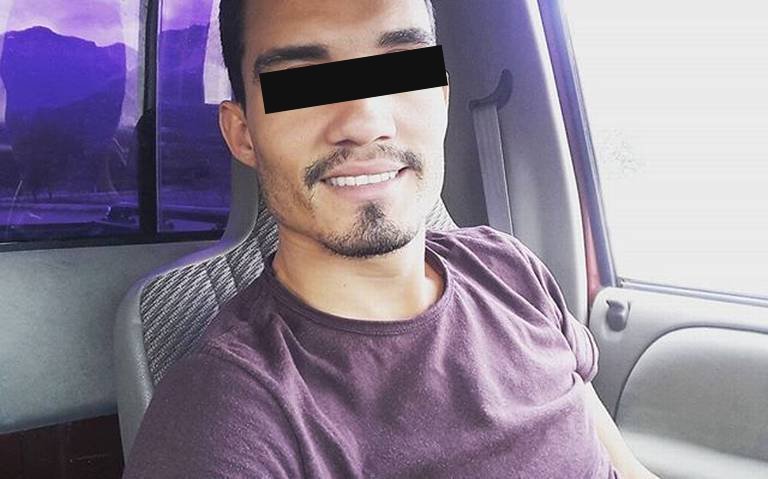
Jaciel Vega Villa, the third alleged suspect in the murder of Miroslava Breach. He is still a fugitive. Image from Facebook
The white house with the metal door in Villas del Rey was inhabited by Wilberth Jaciel Vega Villa, who is still on the run. Vega Villa was a university student one month away from graduating from a degree in human psychomotricity (to care for persons with disabilities, like his sister) and was raised as a brother of Moreno Ochoa. According to the authorities, he was also the author of the Wawa narocorrido that was found in his notebooks as well as the person driving the grey Malibu that transported Miroslava’s killer. A video taken by security cameras shows his face as he drove the vehicle that morning. His vehicle and home were full of evidence that was eventually presented during the trial.

A security camera captured Jaciel Vega Villa in the vehicle that transported Breach’s killer. Source: Chihuahua State Prosecutor General of Justice
His Facebook, YouTube and Instagram accounts show that he has a son, and that he likes music. In several images he is seen singing. In fact, a witness indicated that he appears in the music video of the corrido-genre song La China, which is dedicated to a drug trafficker.
Our investigation discovered that he has a half-sister who was a federal police officer in the tourist town of Creel, and that two complaints against her were lodged at the state’s human rights commission. This half-sister was also a witness to Moreno Ochoa’s wedding and is also the lawyer of Jesús Alfredo Salazar Ramírez (a.k.a. El Muñeco), detained at Almoloya prison since 2012, accused of crimes against public health and criminal conspiracy. Salazar Ramírez, who is said to be the successor to Don Adan, was accused of the murder of an activist named Nepomuceno Moreno Núñez and a massacre of 13 people in the town of Creel. His extradition to the United States has been blocked by a judge. Salazar Ramírez is Jaciel’s godfather.

Alfredo Salazar Ramírez was arrested in 2012 on drug trafficking charges. A judge issued an injunction against his extradition to the United States. Source: Office for National Defence
A pause is necessary here. Several versions indicate that Vega Villa was taken before the authorities in order to make a statement about the murder some time between March 23 and 25, and that he was not detained. This news was reported by the media at the time and confirmed a year later by Chihuahua’s state interior secretary César Jáuregui, who admitted that at the time the suspect’s identity was not known. He later took this statement back, after governor Corral and state attorney César Peniche furiously contradicted him.

Statement from the Chihuahua government denying that Jaciel Vega Villa, one of the three suspects in the murder, was ever detained. Source: Government of the State of Chihuahua Office of Social Communication
Our team found testimonies from one of Jaciel’s relatives and from a police source who both insist that Jaciel did speak to the authorities before his home has identified and inspected.
If this information is true, it would not be the first time that someone related to the Salazar family was released after having been brought in by the authorities. Miroslava’s stories from 2000 show that clan patriarch Adán Salazar was released even though he had been arrested in possession of military-grade weapons and was already identified as a drug trafficker.
The Official Story
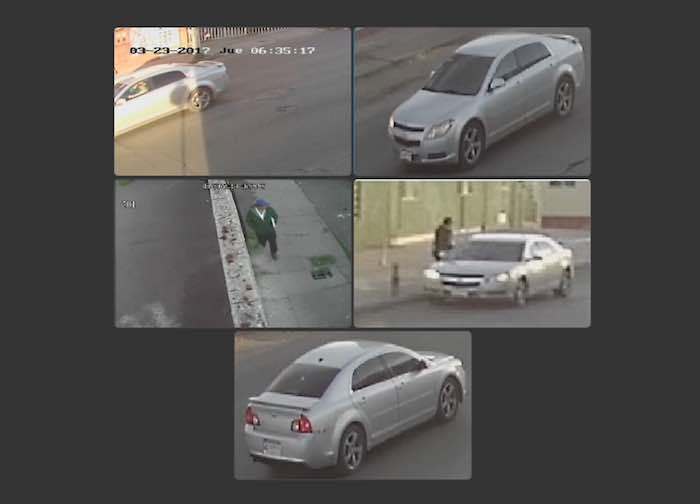
Security cameras captured the grey Malibu that transported Breach’s killer to her home. Source: Chihuahua State Prosecutor General of Justice
Inside the grey Malibu where the notebook with the song in honour of Wawa was located, authorities say they also found a key to a Quality Inn hotel in Chihuahua city, as well as a Water and Garbage Disposal Central Committee receipt from a home located in the same Villas del Rey neighbourhood.
In this address authorities found a university student who confirmed that the grey Malibu was being driven by his schoolmate, friend, neighbour and fellow Chínipas resident Jaciel Vega Villa.
Later, the young man, known as witness Juanjo, whose identity is being protected, spoke to officials about how his neighbors Vega Villa had asked him to check if there was any strange activity near his home. In an elaboration of that statement, which was allegedly voluntary and spontaneous, Juanjo informed state authorities that on March 21 and 22, 2017, just before Miroslava’s murder, he found out that Vega Villa had met with Moreno Ochoa. In fact, in a strange instance of self-incrimination, Juanjo said that he sought them to buy drugs from El Larry. From the outset, Juanjo volunteered his cellphone to investigators, which is how they obtained Jaciel’s cell phone number.
With that number, authorities were able to obtain records of incoming and outgoing messages and phone calls, the duration of each, internet sites visited, and the location of the antenna that serviced calls to that cell phone and seven others. The authorities were able to establish that on March 23, Jaciel—who was using an ex-girlfriend’s cellphone—made 37 calls to nine different phone numbers and received 26 calls from 13 numbers. The office of the Chihuahua State Prosecutor claims to have been able to identify the owner of two numbers with whom Jaciel communicated on the morning of Miroslava’s murder: one belonged to Juan Carlos Moreno Ochoa and the other one, with an area code from Sonora state, was traced to hitman Andrés Zabala Corral, thanks to his linked Facebook account.
The three numbers used the coverage of a cell phone tower located 200 meters from Miroslava’s home between 6:35 and 6:50 AM on March 23. Jaciel communicated with Moreno Ochoa seven times, and once with Andrés Zabala.
That day, Vega Villa sent text messages to a number associated with his brother, Iván Jew Vega Villa, on two occasions. He also called a phone number registered to his mother 12 times.
On March 23, Vega Villa communicated at 5:47 AM with a protected witness known as Estrella, a friend with whom he had planned to travel that morning to Chínipas. Vega Villa also had contact with a witness known as Rubi (whose name will come up again later) at 16:01, as well as with his friend Juanjo at 17:45. He also placed two calls to the Sahuaros taxi company and, at night, a one-minute call to the Conocor air taxi company.
Eleven of the numbers with which Vega Villa communicated were not identified: eight had Chihuahua area codes, two were based in Sonora, and one more (called at 18:49) was located in Mexico state. Even though it is not known whom he called, Alfredo Salazar is imprisoned in that state, and Crispin, Don Adan’s oldest brother, lives in Sonora. He also called Juan Carlos Moreno Ochoa 26 times.
Thanks to having access to Juanjo’s phone, investigators discovered that on March 25 at 14:29, Vega Villa sent a photo to a WhatsApp group announcing his arrival in Chínipas, which is where people related to the case claim he continues to hide to this day.
The authorities found another document in the grey Malibu. It is a permit granted to an airplane pilot by the Communication and Transport Secretariat (SCT) on February 27 2017, “certifying the ability, licence or permit for flight personnel”. Our team was able to establish that it was assigned to a pilot who had an accident in 2011 involving a Cessna airplane in Sinaloa state. But the authorities did not investigate this document or its owner.
The Vaio Laptop
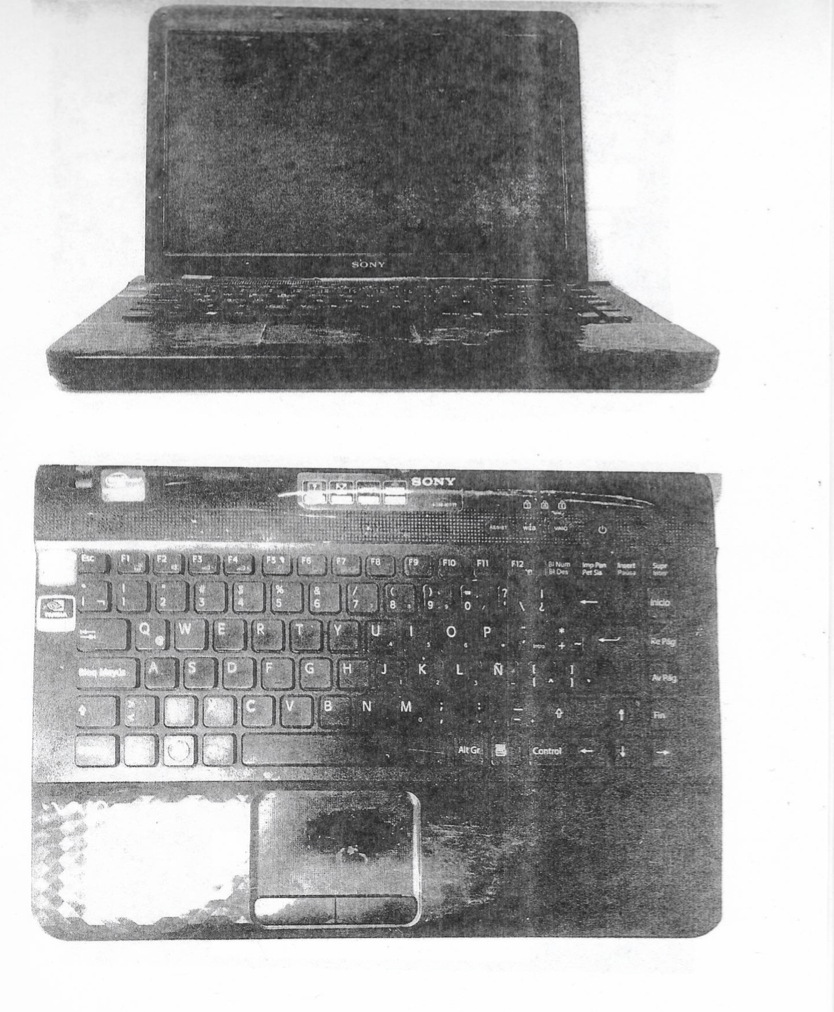
The laptop found during the search in the Villas del Rey home with the audio files of the threatening call that Breach received asking her to reveal her sources. Source: Chihuahua State Prosecutor General of Justice
During the inspection of the Villas del Rey home on March 26, investigators found nine cellphones and five new SIM cards in drawers, as well as documents related to the home’s residents and their daily lives. On the dining table they found a key piece of evidence: a black VAIO laptop, model number PCG-61911.
In the case file, the laptop’s picture is blurry. Its location in the crime scene is not clear.
That same night, the black laptop was sent to the office of the head of Chihuahua’s prosecutor investigative department. On March 31, results of the analysis of the laptop’s contents were available, including two MP4 audio files. On April 4, authorities requested these files, which were sent that same day to a team of investigators at the Attorney General’s Office on a CD, along with their transcriptions.
The files contain two recordings in which the same man first asks Miroslava and then asks Patricia Mayorga, a journalist for Proceso also from Chihuahua, to reveal their sources. He specifically refers to an investigation they published, which linked Los Salazar to the PRI’s nominee to the Chínipas municipal presidency.
In the first recording the man tells Miroslava in a familiar tone that “they” and “these guys”—in reference to the drug traffickers in the town—suspected that staff at the municipal presidency was behind the leaks regarding the family connections of a candidate known as Juanito. Breach responded, angrily, that she was her own source because she was from Chínipas and she knew what happened in town, and that if anyone had a problem they should hold her responsible.
(Alfredo Piñera, then a spokesperson for the PAN, recorded a call with Miroslava Breach in which he asked her to identify the source that told her that a relative of Los Salazar was running for municipal mayor in the Chihuahua highlands for the PRI. Source: Chihuahua State Prosecutor General of Justice)
Miroslava Breach (MB): Well, they’ve warned you, but tell him: “Do you want to fuck someone up? Fuck the journalist, you know who she is.” And let them come after me. They know it full well, that’s why I signed the article.
Man (M): Well, Miroslava, that’s everything, then. That’s more than enough.
MB: I mean, that’s why I signed the article, because I knew. I have cousins, uncles in Chínipas. Let them know that it was me, and that no one told me anything. I’ve known them all my life.
M: Alright, that’s fine.
MB: It’s that simple. It’s that clear.
M: What’s happening is that they’re worried. They’re really worried, because they think it was someone from there, the municipal president.
MB: No, no. Tell them clearly. I insist. One of my aunts spoke to me. She was crying because the pressure has been so intense. But I told her, “Aunt, that’s why I signed the article, because I know what it’s about and they know I’m from Chínipas“.
M: Right.
MB: I was born there. My family is from there.
M: Well, that’s fine, Miros. Thank you. I’ll tell them that.
MB: Tell them that, and tell them that I’ve got more ovaries than they’ve got balls.
M: I’ll tell them, just like that.
MB: Tell them.
M: Haha.
MB: It’s because silence is collusion, and that’s what’s caused all of these problems.
Speaking in the third person, Breach explained to the man: “Miroslava Breach Velducea was born in Chínipas and she will not reveal her sources. So, please, tell them [who the source is] and to say it was me. That’s why I signed the article, because I’ve got ovaries and I know how things are.” She ended by saying “silence is collusion”.
In a statement to the authorities dated May 17, 2017, the mayor for the PAN party (whose nickname in the hearing was Boby) claimed that this was his way of showing organized crime that he had not been the one to leak the information about the narco-candidates since they were beginning to suspect him, and that he knew that El Larry was dangerous.
Even though Piñera claimed that the call to Miroslava had taken place on May 6, 2016, it was in fact made in June, according to two other witnesses. Nine months later, the recordings would be found in a laptop in a home in Villas del Rey that, by the way, is not the Apple laptop that Jaciel is seen using in his social media pictures contained in the case file.
On November 25, 2016, in the famous op-ed column that Miroslava published under the pseudonym Don Mirone in which she wrote sharply and fiercely on state politics, she made two serious allegations against mayor Schultz. She accused him of having “had Martin Ramirez Medina, nephew of regional drug lord Crispín Salazar Zamorano, as director of the municipal police during his entire three-year term”, and of having ignored crimes that he had committed. He also accused Schultz of having been “a messenger for Salazar, in his bid to intimidate journalists who were documenting what was happening in the region”. Here, Miroslava was referring to herself.
Miroslava’s loved ones knew that Schultz had sent her a message: that she should “never step foot on these highlands”, as protected witness Mila’s testimony revealed after being read during a hearing. Two other testimonies by relatives confirm there was such a warning. Another testimony read during that same hearing mentions that “someone named Schultz is annoying” and coordinating with El Larry, who controls the town. It does not detail, however, which Schultz it refers to, in a region where it is a common last name.
Despite the existence of these recordings and testimonies demonstrating the connection between politicians in Chihuahua and organized crime groups, the criminal investigations only focused on El Larry, his relative Wilberth Jaciel Vega Villa and hitman Andrés Zabala. They did not inquire into the possible participation of political actors in Miroslava’s killing.
In his statement, mayor Schultz was only asked about the recording. He was never asked about the control that El Larry or Los Salazar had over the municipality he governed, their role in the local elections, nor about the person he appointed as chief of municipal police.
The Hideout
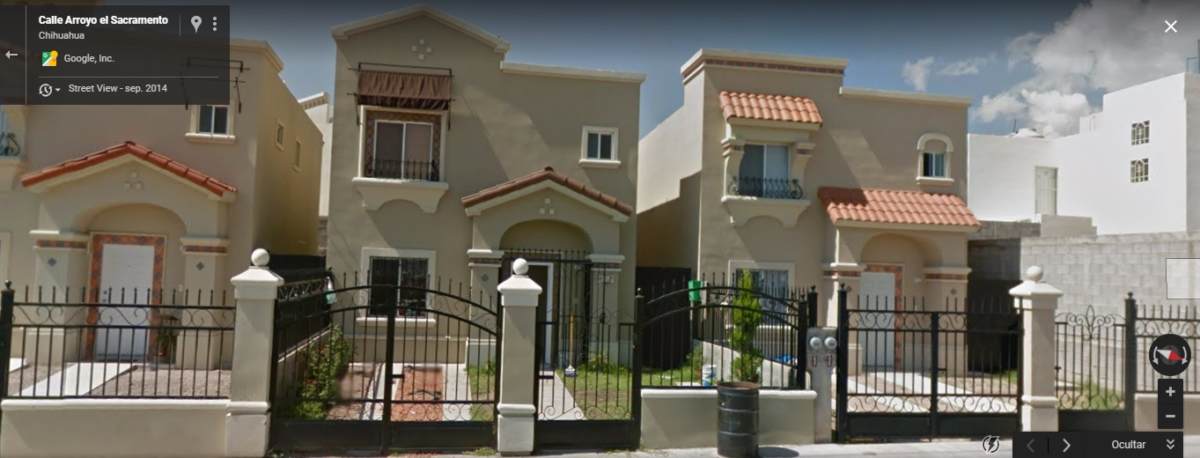
In the Quinta Balboa neighbourhood, El Larry and Andrés Zabala stayed in the home of a female police officer after the murder in March 2017. Taken from Google Maps
Two months after Miroslava’s murder, the authorities located the second vehicle used in the crime: the white Malibu driven by Cholugo, who claimed that while he did in fact drive the killers to their destination on March 23rd, he did not know that they had committed a crime.
This thread in the case began when the owner of a mine in Témoris, a municipality adjacent to Chínipas, asked an acquaintance—now protected with the moniker 1981—to drive a friend that was about to visit Chihuahua. And he did. On the night of March 22, 1981 asked his employee, Cholugo, to fetch his white Malibu and meet his client: Moreno Ochoa, a.k.a. El Larry.
In the early morning hours of March 23, Cholugo picked up El Larry from the home in Villas del Rey. His passenger then asked him to follow the grey Malibu, whose young occupant would then show him where to pick another person given that he had to go to his university. Cholugo parked the vehicle on a street near the Granjas neighborhood while El Larry spoke on the phone. At approximately 7:00 AM a man came running and hopped on the vehicle. El Larry chastised him for being late, which had caused the pair to miss their flight. The other man—we would learn later—was the triggerman, Zabala Corral.
Since they were not going to make it on time to Chihuahua to board their plane, El Larry ordered the driver to take them to the Marrod Hotel. “He told me to go in”, said the driver. “I parked in front of rooms 119 and 120. The young man got out of the car, they both entered room 120, and from there I went back home, at about 10:30 or 11:00 in the morning.” 1981 was with the two men for almost four hours. He then dropped his bosses’ car off at a garage.
The Chihuahua Prosecutor’s office gave Cholugo protected witness status, without considering him a potential accomplice.
A taxi driver from the Sahuaros company which services the Villas del Rey area, identified as Señor Paco, provided a statement that contradicts Cholugo’s story. Señor Paco said that on March 23, at 9:00 AM, he was called to La Torre street, where he picked up a pair of men later revealed to be El Larry and Andres Zabala, and took them to a home located in the middle class neighbourhood of Quinta Balboa.
The home belonged to El Larry’s wife, who was renting it to a niece. The woman who hosted them, a state police officer, was given the pseudonym Rubi during the investigation.
In her statement, Rubi mentioned—as did others in the case—that her uncle is a drug trafficker who operated out of Chínipas, and that when El Larry and a stranger with a Sonoran accent (Andrés Zabala) were in the home they were armed. She stated that in the morning of March 25, the pair, together with Jaciel Vega Villa, left for the airport to board an air taxi to Chínipas. That day, however, there was no room aboard the airplane for Andres Zabala, who returned to the same home for one more night.
These trips to and from the airport were made in a cherry-colored SUV. It is not known who the drivers of this vehicle were. Nor this question is in their deposition to authorities. There is no evidence in the case file that investigators attempted to follow this lead. Rubi, the woman who hosted El Larry and Andres Zabala, was granted protected witness status, rather than being considered a potential accomplice.
The search carried out at the Quinta Balboa home makes mention of a notebook containing a phone number: that of a company that claims to be able to curate personal information to avoid surveillance.
The Other Hideouts
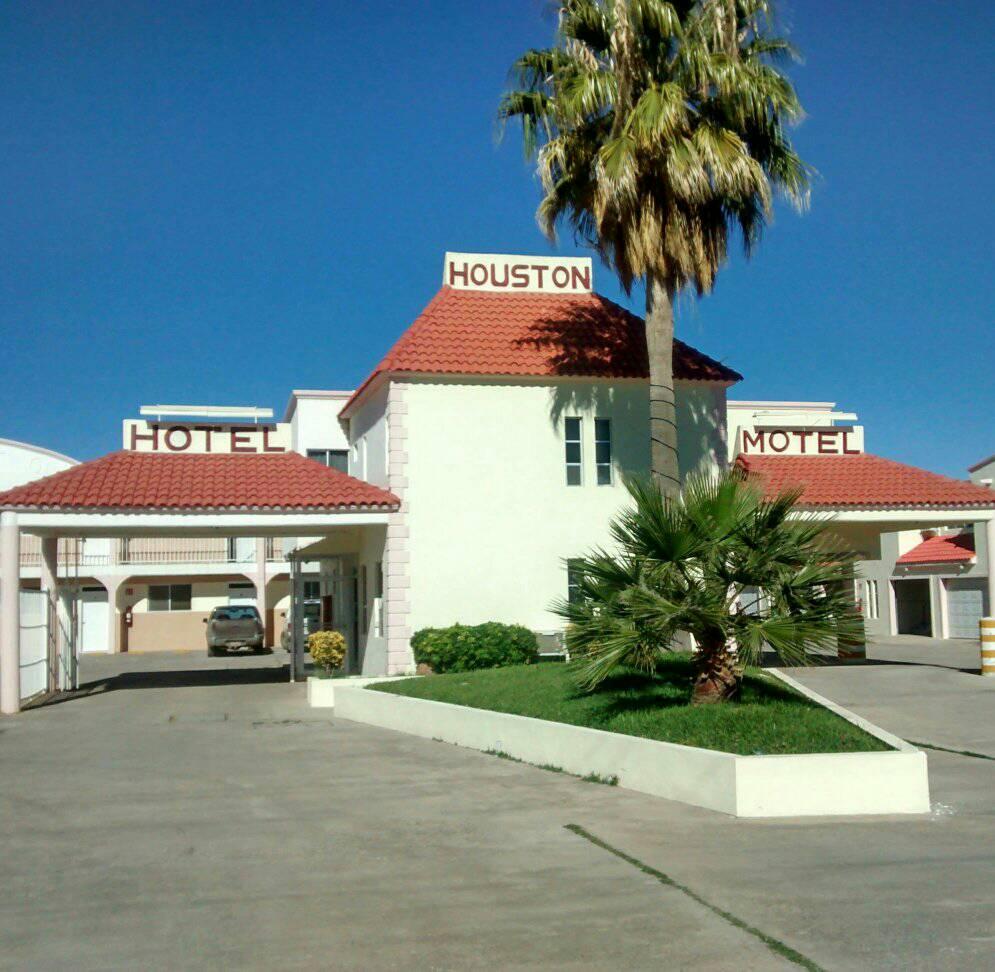
In Miroslava’s murder case file, two staff at the Hotel Houston mentioned that an individual resembling the triggerman stayed there for several days. Taken from Google Maps
During the preliminary hearing of December 27 2017, the public prosecutor read aloud the statements of two employees of the Houston Hotel, who claimed that on March 26, 27 and 28 they had a mysterious guest who never left his room nor allowed them to clean it. This man always donned the same clothes: a green sweatshirt, a t-shirt, black pants and shoes, and on some occasions, a cap. He dressed exactly in the same style (reminiscent of a private security guard) as the man carrying the white object –the cardboard sign- beneath his arm in the CCTV camera footage near the scene of the murder.
The two employees declared this in November, and according to the case file, after eight months, they were able to give these details and identify Andrés Zabala when the prosecutors showed them his photograph.

Andrés Zabala is alleged to have been the man who shot Breach. His body was found on December 19, 2017 in the Álamos municipality of Sonora state. Image from Facebook
On December 19, 2017, Chihuahua authorities announced that Andrés Zabala had been found dead, shot in the back, in Alamos, Sonora state, near the border with Chihuahua. Six days later, on December 25, governor Corral announced that Juan Carlos Moreno Ochoa, or El Larry, had been arrested. To this day, he remains the only person arrested and facing trial in connection with Miroslava’s murder.
Governor Corral claimed that Moreno Ochoa was both the mastermind and the one who carried out the murder, effectively putting an end to any line of inquiry into the narcopolitics angle of the case.

Javier Corral announced the arrest of Juan Carlos Moreno Ochoa, a.k.a. El Larry, on December 25, 2017 with a tweet in which he called him the “mastermind” of the crime. Tweet from Javier Corral (https://twitter.com/Javier_Corral/status/945349246340841472)
Hidden Clues
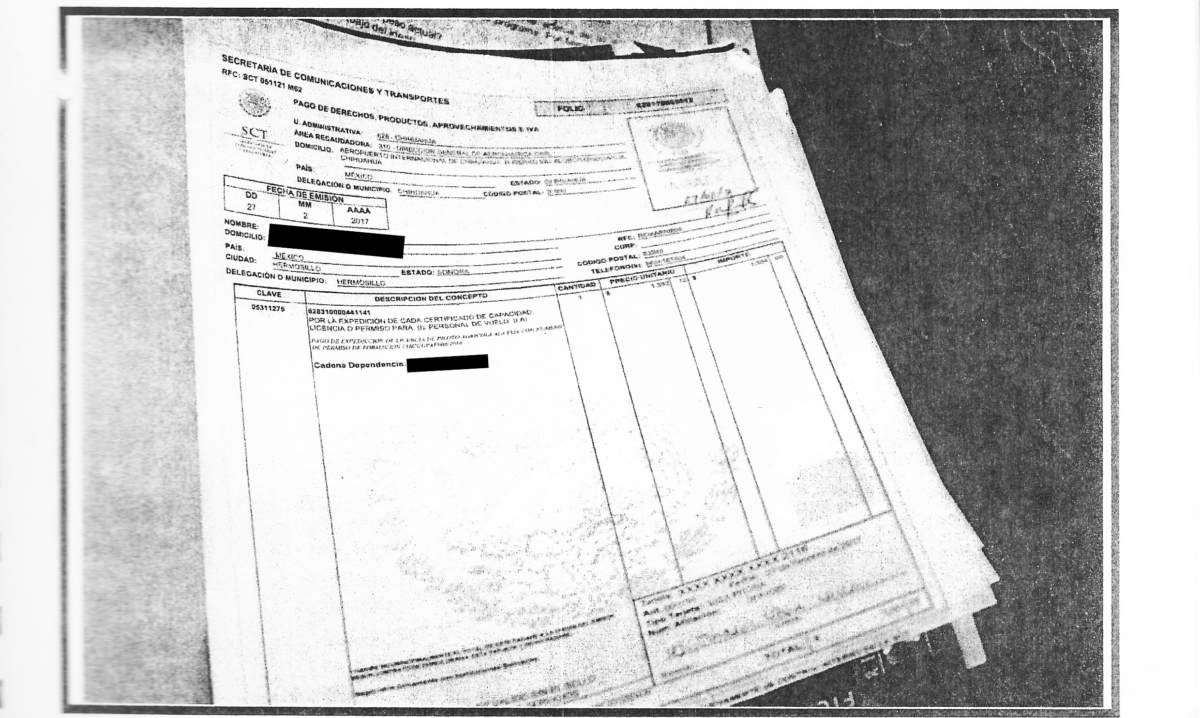
During the search of Jaciel Vega Villa’s home in Villas del Rey, the authorities found two receipts: one, for water, that corresponded to his friend’s home, and the other, a document from the Communication and Transport Secretariat to a pilot. There is no evidence that this was investigated. Case file 19/2017-8019
By identifying three people implicated in Miroslava’s murder, the authorities were able to create a theory of the killing that seemed to bring clarity to the case. The investigation has not considered that more people could have been involved in the murder. However, to this day, the authorities have not accounted for why exactly these three men accused of her murder killed her.
Until today, Juan Carlos Moreno Ochoa (El Larry, and according to the authorities, also El Wawa) maintains his innocence, has refused to provide information to investigators, and yawns loudly during court proceedings.
Both Cholugo and Rubi escaped accusation, by being granted protected witnesses status by the state authorities. There is no evidence that authorities investigated other names mentioned by 1981, as have seen speaking to El Larry in March when he chauffeured for him, including once to an airstrip in the city of Aldama.
Likewise, the two PAN party members implicated in the events (Alfredo Piñera and Hugo Amed Schultz Alcaraz) were both granted protected witnesses status and were even able to continue with their political careers. Piñera was hired in 2019 as an advisor to the PAN’s parliamentary caucus leader, and Schultz went on to become the education coordinator for the highland region at the state Education and Culture Secretariat, and still retains his position as a teacher in Chínipas. Schultz announced his intention to become the head of the PAN’s state committee in Chínipas.
The authorities also appear to not have carried out an investigation into the air transport companies that operate out the Chihuahua airport or the private aircraft that the suspects might have used to leave the city. This, despite that the authorities’ official version of events includes the allegation that the three men left the city by air.
The Federal Investigation
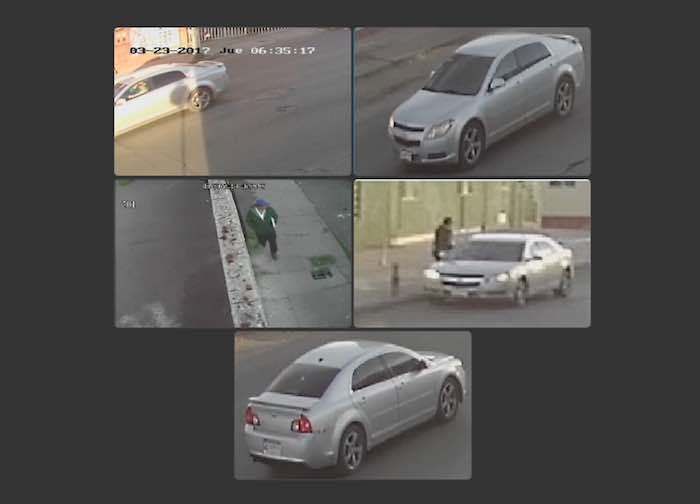
The three alleged suspects in the murder of Miroslava Breach used a two Malibu vehicles, which evidence suggests were tracked by the prosecutor’s office to two owners. Source: Chihuahua State Prosecutor General of Justice
The “exemplary investigation” carried out by the Chihuahua state prosecutor’s office was based on the analysis of more than 200 hours of CCTV footage both from public streets and private properties, the search of vehicle databases, the search of homes, and the interrogation of at least 33 witnesses and people related to Miroslava. All these acts took place exclusively in the city of Chihuahua.
(The government of Chihuahua presented the investigation into the murder as “exemplary”, to be replicated across the country to investigate crimes against journalists. https://www.youtube.com/watch?v=KitOt6TTNdk&feature=youtu.be. Source: Social del Gobierno del estado de Chihuahua)
However, the case file does not include evidence of any facet of the investigation being conducted in Chínipas, which is where Moreno Ochoa and Vega Villa fled to, and where the groups that Miroslava wrote about—and which threatened her prior to her killing—operated. The case file similarly lacks evidence of any investigation into the political protection that these same groups received from the authorities, according to her stories.
On October 6 2017, governor Javier Corral said during a radio interview that he had requested assistance from the Mexican Government’s Interior Ministry. He explained that help from federal authorities were needed because the culprits of Miroslava’s murder were “organized crime leaders who have weapon caches at their disposal and hide in difficult to access areas, two factors that have hindered their arrest”.
When a journalist with our team asked state prosecutor Carlos Mario Jiménez about these gaps in the investigation on February 9 2018, he said: “This question about whether someone from an organized crime group [is involved in the murder], that would have to be investigated by the Federal Prosecutor General’s Office”. The Chihuahua prosecutor replied, “We have exhausted up to this point a certain level of investigation” and added that should it be discovered that other parties were involved in the murder, it would be up to other authorities to carry out the investigation.
In April 2018, four months after El Larry was captured and one year after Miroslava’s murder, the Specialized Division on Crimes Against the Freedom of Expression (FEADLE) of the Federal Prosecutor General Office took over the investigation, despite objections and a legal challenge from the Chihuahua state prosecutor’s office. With this move, the state authorities had no choice but to leave the matter to national authorities.
Asked about inconsistencies in the case, the head of FEADLE, Ricardo Sánchez Pérez del Pozo, said that his office had reviewed Miroslava’s notes, but would not say if they had expanded their investigation to Chínipas.
“The execution of an arrest warrant is information that should be handled confidentially and very carefully. What I can tell you, what I am legally allowed to tell you, is that the authorities have worked and continue to work permanently in order to carry out the arrest warrants that have been issued,” Pérez del Pozo said.
“Have investigators been sent to the field?”, we asked Pérez del Pozo.
“I cannot reveal that information”, he replied. “But I can tell you that federal authorities are working in coordination to carry out arrest warrants, and that they’re working on this.”
(The prosecutor’s office that specialices in crimes against journalists,FEADLE, took over the investigation into Miroslava’s murder. The official said that he could not give details into the investigation because that would put the case at risk. Source: Interview conducted by the Colectivo 23 de Marzo with Ricardo Sánchez Pérez del Pozo)
For Pérez del Pozo, the narcopolitics line of inquiry is not closed, but he has yet to announce any progress on that front of the investigation.
The FEADLE case file shows that new individuals have already been investigated. These include Mario Vázquez and José Luis Luévano, the head of the state PAN committee and his second-in-command, both of whom headed the party when Schultz asked for help because he was being threatened over stories published in La Jornada, El Norte de Ciudad Juarez and Proceso. Neither of the two men was apparently questioned on the topic of narcopolitics.
It still remains unclear why the PRI party leaders decided to select Juan Salazar Ochoa, nephew of the clan leaders, as their candidate, if Miroslava was right in signaling Schultz as a messenger of that group and responsible for threats to journalists, in pointing to the control of Los Salazar in the area and in the political collusion protecting them.
FEADLE also ordered an investigation into the properties and social media presence of five journalists close to Miroslava. One of them, Enrique Lomas, currently works in the press department of the Chihuahua state government.
As far as this Colectivo is aware, no one has clarified how exactly Andres Zabala, the alleged triggerman, was murdered. Similarly, several murders related to the case have yet to be properly investigated, including the death of two teenagers who were allegedly struck by the airplane carrying Miroslava’s killers when it was landing in Chínipas, as well as those less than a month after Breach’s murder of ta pilot and a retired martial arts teacher, both of whom who were deceitfully linked to the crime.
Jaciel Vega Villa, the suspect on whom the most information was collected and Alfredo Salazar’s godson, is still on the run more than two years after he was released by the state judicial authorities following his questioning.
El Larry’s trial is currently stalled, as a witness in the case is now refusing to testify. A judge ordered the extradition of Jesús Alfredo Salazar (a.k.a. El Muñeco) to the US. Another judge ordered an injunction against his extradition. On July 20, La Jornada reported that nine cloth banners (narcomantas) appeared in different cities of the state of Sonora indicating that Los Salazar had killed Miroslava.
“Sonora Governor Mrs. Claudia Pavlovich and Mr. Public Security Minister Alfonso Durazo, those ordering executions in Cajeme and killing policemen are Mr. Adán, Alfredo and Krispín Salazar, responsible for moving cocaine from Mexico to the US and for violence against public officials and policemen in Chihuahua, are also responsible for the murder of journalist Miroslava Breach in that state,” said messages attributed to a rival drug trafficking group.
In Chihuahua, the press reported that Los Salazar threatened governor Corral with another cloth banner. On August 9, after the murder of Los Salazares’ boss in Hermosillo (capital of the State of Sonora), Los Salazar allegedly left another banner in the capital of Sonora threatening governor Pavlovich, allegedly due “to non-compliance with commitments which is paid for with blood” . Pavlovich in return lodged a criminal complaint in the Federal Prosecutor General’s Office in the state against those responsible of the message for libel, threats, extortion and blackmail.
In an interview in Mexico City, governor Corral said that Los Salazar are responsible for the crime, but that the Federal Prosecutor’s General Office has done nothing about it. FEADLE continues to claim that it cannot offer any new details on the case, and that even though no new evidence can be introduced in El Larry’s trial, the investigation continues. Moreno Ochoa’s lawyer said that he would not comment on the case until after the conclusion of the trial.
The Chihuahua state prosecutor did not respond to requests for an interview from the Colectivo 23 de Marzo to be able to comment on our story. On May 17, César Peniche told the press that the investigation into Miroslava’s murder has resulted in better knowledge of criminal structures. Leads might have nurtured various case files, but they did not seem to be enough to investigate the murder of Miroslava herself.
This is the “exemplary investigation” that the authorities have carried out in the case of Miroslava Breach’s murder. It was governor Corral himself who proposed that this investigation would serve as a guide for all others into the killing of journalists in the country, one that was emulated by federal authorities. This is a model that, as this investigation has found, does not follow to many of the cases’ central leads and that can only counter many questions with silence. A silence that—as Miroslava said herself—becomes collusion.
Read the second part of this series tomorrow
